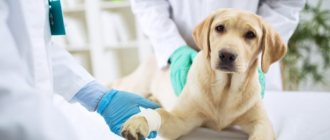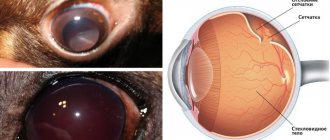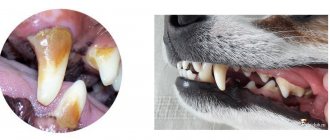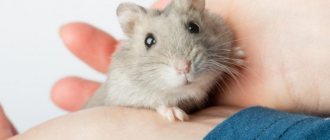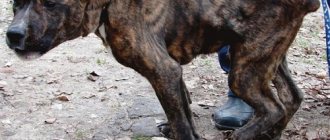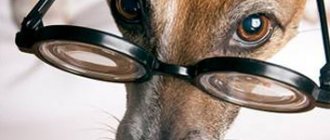In this article I will write about such a common cancer in dogs as mammary tumor. Tumors can be benign or malignant (cancer). Bitches are more often affected, but sometimes such tumors also occur in males.
I will list the forms of breast cancer and discuss in detail the symptoms and diagnostic methods. I will give a life expectancy forecast. I will analyze treatment regimens and methods of palliative care for terminally ill animals. I'll tell you how to prevent this serious disease.
Causes of mammary tumors in dogs
The entire world of science has been struggling to find out the causes of cancer for many decades. Humanity has made sufficient progress in this direction. The causes of mammary tumors in dogs can be divided into two large groups: internal and external.
Internal factors
- Hormonal disorders.
- Frequent false pregnancies.
- Inflammatory diseases of the mammary glands.
- Cystic lesions of the ovaries.
- Old age (over 9 years).
- Hereditary predisposition.
Nature has programmed living beings for the regular birth of offspring.
Cyclic processes occur in a dog’s body in preparation for pregnancy and childbirth. At the same time, various hormones are intensively produced. If pregnancy does not occur, hormonal metabolism is disrupted and various pathologies arise. The most common is the so-called false pregnancy - a special condition that simulates pregnancy, childbirth and feeding puppies.
At the age of 10 years, according to veterinary statistics, every fifth dog undergoes a neoplasm
About two months after estrus, the dog becomes restless and acts as if she is about to give birth and feed puppies. She sets up a rookery in a secluded corner, sometimes she begins to nurse some toy - licks it, hugs it, whines gently.
At the same time, the mammary glands swell and may become swollen, and a discharge resembling colostrum comes from the nipples.
Swollen and weeping soft nipples itch and bother the dog; she licks and even bites them to relieve the itching.
This leads to microtraumas, infection and the formation of foci of inflammation and compaction.
External reasons
Unfavorable environmental conditions
The environmental picture in big cities is depressing. Exhaust gases, reagents, emissions from enterprises, improper disposal of devices containing mercury and other toxic components - all this has a detrimental effect on both people and animals. Dogs constantly sniff the ground, therefore they come into very close contact with harmful substances and are at risk.
Fibroadenomatous hyperplasia of the mammary glands
Regional mastectomy in dogs
Mastectomy
(from ancient Greek mastòs “breast” and ek tome “remove”) - a surgical operation to remove breast tissue. The essence of the operation is to remove the mammary gland, fatty tissue that contains lymph nodes (probable sites of metastasis), and also, depending on the stage of the oncological process, removal of the superficial pectoral muscle, possibly part of the abdominal wall.
Indications for surgery
• Breast tumors
(the most common reason for mastectomy in dogs and cats) • Suppurative process, severe mastitis with gangrene of most of the mammary gland, or serious wounds of the mammary gland (although this is quite rare).
There are several options for this operation:
• Unilateral mastectomy
- includes the removal of the entire ridge of five mammary glands on one side, subcutaneous tissue and regional lymph nodes (axillary and inguinal).
Always used in cats
and most often in
dogs
.
• Bilateral mastectomy
- characterized by an increase in the volume of surgical intervention: with this method, two ridges of mammary glands are removed from both sides along with regional lymph nodes (axillary and inguinal). This operation is very traumatic, difficult to tolerate and should be avoided.
• Regional mastectomy
It is performed exclusively in dogs and will be discussed in this article.
It is used only in dogs, since this operation is not practical in cats. In order to understand what a regional mastectomy is and why it is needed, you need to know some basics of oncological surgery
and animal anatomy, in particular the structure of the lymphatic system of the mammary gland.
Lymphatic system of the mammary gland
Dogs and cats normally have five packets of mammary glands on both sides. The first and second pairs of mammary glands have regional lymph drainage to the accessory axillary and axillary lymph nodes. The fourth and fifth pairs of mammary glands have lymphatic drainage to the inguinal lymph nodes, and the third pair has mixed lymphatic drainage (both axillary and inguinal lymph nodes).
Basic concepts of oncological surgery:
• Zoning:
involves excision of areas along the path of regional lymphatic drainage with the tumor and surrounding healthy tissue (this is subcutaneous tissue containing lymphatic vessels and lymph nodes of the first and second order).
• Blocking:
involves excision of the tumor and the area of potential invasion of its cells as a single block. For example, in case of a breast tumor, it is necessary to remove the additional axillary lymph nodes and the tissue containing them as a single block.
That is why, if a tumor appears in the first or second pair of mammary glands, the first, second and third pair with axillary tissue and lymph nodes must be removed. If a tumor appears in the fourth or fifth pair, the third, fourth and fifth pairs of mammary glands with inguinal tissue and lymph nodes are removed. And in case of a tumor in the third pair, all mammary glands and both groups of lymph nodes are removed, as this ensures the radicality of the operation.
A regional mastectomy in dogs involves the removal of at least three mammary glands on one side. And in most cases, this operation is needed for cancerous lesions of the breast. Failure to comply with these simple principles will lead to the development of tumor relapses at the site of its removal.
Main stages of the operation
1. A bordering skin incision and removal of breast tissue with subcutaneous tissue. 2. Axillary lymphadenectomy - removal of tissue containing the axillary lymph node located in the axillary region (there is no need to look for the inguinal lymph node, since it is removed along with the mammary gland). 3. Suturing the wound.
Complications after regional mastectomy
• Bleeding in the early postoperative period. It occurs rarely; when using an electrocoagulator, this problem can be solved (most often observed in the presence of blood clotting disorders).
• Suppuration of the postoperative wound. Maintaining asepsis - antiseptics and the use of antibiotics solve this problem.
• Seroma (lymphorrhea) is the release of fluid (lymph and a small amount of blood) under postoperative sutures. Post-mastectomy seroma occurs to varying degrees in many animals. The accumulation of seroma is due to serious surgical trauma, as well as the fact that lymph does not coagulate, unlike blood, and can continue to ooze under the sutures for up to 2-3 weeks. The amount of lymphorrhea may vary. Most often, this problem bothers obese animals and is eliminated by installing drains (plastic or rubber tubes through which lymph flows out) under the seams or by performing evacuation using a puncture (performed with a regular syringe).
Postoperative period
2-3 days of inpatient treatment
, especially considering that such an operation is often needed in older animals. Monitoring of tests and condition is desirable, 2-3 days - intravenous infusion, antibiotics, treatment of sutures and use of a protective blanket. On the second day, the animal can get up, move independently, and walk. Full activity is restored on days 7-10, although this is all individual. Sutures are removed on days 12-14 depending on healing. For the first few days, painkillers are usually prescribed.
So, regional mastectomy is most often used for the radical removal of tumors in the first, second, fourth or fifth packages of the mammary glands in dogs, includes the removal of at least three packages, is rarely used for the radical treatment of purulent mastitis and almost never as a palliative operation for mammary tumors glands in cats. The duration of this operation is less than an hour and its complexity is low, unlike, for example, unilateral mastectomy, where the surgical trauma is much higher and the surgical intervention is more invasive. The postoperative period most often passes without complications if the veterinarian’s prescriptions are followed correctly and accurately.
Main forms of cancer
- Nodal
- Diffuse
The nodular form of breast cancer is manifested by the appearance of dense nodules in one or more mammary glands. The nodules can be single or form a group.
To the touch, the neoplasm in the initial stages resembles a pebble stuck under the skin: it rolls freely and has clear boundaries.
The skin over such a tumor remains healthy for a long time, the tumor does not hurt or bother the pet. General condition is good.
In later stages, the tumor fuses with the skin and surrounding tissues, redness and ulcers appear. The general condition worsens, the process of metastasis invades other organs. Lymph and blood are involved in the transport of cancer cells. Usually the lymphatic system is affected first (the lymph nodes become enlarged and inflamed). Metastases then appear in the lungs. The liver, heart, adrenal glands and bone structure may also be affected.
Cancer metastases
The diffuse form of cancer is characterized by blurred boundaries of the affected area. The tumor is “embedded” in the tissue, affecting the entire gland at once. It is voluminous, painful, hot to the touch, fused to the skin. Symptoms resemble an abscess - large tumor sizes, discharge mixed with pus and blood, increased body temperature. The skin becomes inflamed, thickens and hardens.
The process of metastasis gives additional symptoms. Affected lymph nodes provoke swelling of the pet's paws. With metastases in the lungs, cough and shortness of breath are observed.
Bone metastases cause lameness.
Types of breast cancer in dogs
A dog has 10 mammary glands, each of which can become the site of tumor formation. Most of them are found in the 2 sets of glands closest to the hind legs.
The average age of animals in which they are diagnosed is from 10 to 11 years, i.e. most often these are quite old dogs. Statistics from veterinary hospitals indicate that pathologies often appear in representatives of the following breeds:
- poodle;
- English Spaniel;
- British Spaniel;
- English Setter;
- pointer;
- fox terrier;
- Boston Terrier;
- Cocker Spaniel.
But for Chihuahuas and boxers this figure is much lower than for other breeds.
As for the types of neoplasms, according to statistics, up to 50% of them are represented by breast tumors in bitches. They are distributed as follows:
- 60% benign;
- 40% malignant.
Important! Cancer develops quickly, but it is not immediately noticeable. Therefore, by the time the diagnosis is made, 2
–
6 months.
Benign neoplasms
A benign breast tumor is not cancer. This is an increase in the number of cells that occurred due to a disruption in the functioning of the body. This pathology does not penetrate into nearby tissues and does not spread to other parts of the body, like cancer. But it can still become a problem, as it puts pressure on other vital organs - blood vessels and nerves. Therefore, sometimes benign formations require treatment, and sometimes not.
Benign breast tumors are divided into 4 types:
- fibroadenomas;
- simple adenomas;
- benign mesenchymal tumors;
- intraductal papillomas.
Adenomas are benign formations that develop on the epithelial tissue that covers all organs and glands. If necessary, adenomas are removed surgically.
Fibromas (or myomas) are tumors of fibrous or connective tissue. In its structure, this tissue is similar to scars and feels like a hard formation under the skin.
Accordingly, fibroadenoma is a formation that consists of glandular and connective tissue. Some of them are very small. Fibroadenomas can remain constant in size or change, periodically increasing and then decreasing. It feels like a round hard lump under the skin.
Mesenchymal tumors arise from cells of mesodermal origin that develop in bone, cartilage, or other connective tissues, including blood vessels, adipose tissue, smooth muscle, or fibroblasts.
Did you know? The earliest fossils of domestic dogs date back to 10,000 BC. e.
Intraductal papilloma is a small benign tumor that forms in the milk duct of the gland. It consists of the gland itself, fibrous tissue, and blood vessels. It usually feels like a small lump near the nipple. May cause nipple discharge.
General characteristics of a benign breast tumor:
- cells do not grow;
- grow slowly;
- do not invade nearby tissues;
- do not give metastases;
- the neoplasm has clear boundaries;
- does not release hormones or other substances;
- Under a microscope, the cells do not differ from ordinary ones.
May not require treatment if it does not threaten health. And, most likely, it will not recur if it is removed surgically.
Malignant tumors
A malignant breast tumor is formed by uncontrollably growing cells. In order to determine whether they are growing or not, the doctor performs a tissue biopsy from the detected tumor.
A tumor whose cells can penetrate into nearby tissues (metastasize) is called malignant. Cells that grow uncontrollably are called cancer cells. Breast cancer starts in the gland tissue and can spread to the lymph nodes if it is not detected early and treated.
There are 6 different types of breast cancer:
- carcinomas;
- tubular adenocarcinomas;
- papillary adenocarcinomas;
- anaplastic carcinomas;
- sarcomas;
- malignant mixed tumors.
We recommend reading the symptoms and treatment of mastopathy in dogs.
Carcinoma is cancer that develops in the body's main cells that make up organs. For example, bone tissue, blood vessel, muscle tissue. It may look like a lump, plaque, or red spot.
Adenocarcinoma is the most common type of breast cancer and begins in the lining glandular cells. They line the internal organs and produce fluids - mucus, digestive juices, etc. This formation feels like a hard lump.
Sarcoma is the rarest type of cancer that forms in connective tissue. It is much less common than carcinomas and adenocarcinomas. But nevertheless, more than 70 types of sarcomas are distinguished, depending on the type of tissue on which it develops. The structure of the tissue is also distinguished: loose, dense, fibrous, spindle cell, etc.
General characteristics of a malignant breast tumor:
- cells can spread;
- grow quite quickly;
- penetrate into neighboring tissues;
- can move to other organs through the bloodstream.
The tumor itself can recover after removal if at least one of its cells remains. Under a microscope, such cells have abnormal chromosomes with darker nuclei and an irregular shape. They can secrete substances that cause fatigue and the animal feels lethargic and not very active.
Important! Metastases of breast cancer occur in 25% of diagnosed cases.
Diagnostics
Any neoplasms in the mammary glands should alarm the owner and prompt him to immediately visit a veterinary oncologist. The specialist will have to make the correct diagnosis, namely:
- exclude diseases with a similar clinical picture;
- determine the type of tumor - benign or malignant;
- if the presence of cancer cells is confirmed, find out the form of cancer, stage and individual characteristics of the course of the disease.
Diagnostics includes a set of methods: visual examination, palpation of the tumor and lymph nodes, biopsy (separation of a piece of tumor tissue for cellular analysis), blood testing, x-ray of the lungs (for the presence of metastases). In some cases, ultrasound, MRI and computed tomography are prescribed.
Mammary tumor in a dog
Etiology, main causes
The mechanisms of formation and development of cancerous tumors are currently not studied so thoroughly in veterinary medicine. Animal body. like a person, it is a rather complex interconnected system. If a failure occurs for one reason or another, natural biological processes are disrupted, which can give impetus to the growth of cancer cells.
The proliferation of tumor tissues is facilitated by the progressive division of cellular structures that mutate at the DNA level . At the same time, the process of dividing cancer cells, which become invulnerable to the body’s defenses, killer cells, can continue for a long period of time.
For example, a benign tumor in the mammary gland in a dog without any symptoms can develop asymptomatically for years. Characterized by a lighter flow. Benign neoplasms have a clear localization, do not affect healthy tissues or other internal organs, and do not metastasize.
In case of a malignant course, rapid growth of a tumor in the mammary gland is noted, which can affect nearby healthy tissues and other internal organs.
Important! The growth rate of pathological neoplasms is individual and largely depends on the physiological, individual characteristics of the body.
A mammary gland tumor in a dog (AMT) can develop under the influence of unfavorable endo- and exogenous factors of various nature, among which are:
- hormonal imbalance in the body;
- chronic inflammation in the mammary gland (mastitis, mastopathy);
- pathologies in the organs of the reproductive system;
- endocrine pathologies;
- age-related changes in the body;
- radioactive, radiation radiation;
- autoimmune diseases;
- frequent false pregnancy;
- difficult pregnancy, frequent difficult childbirth;
- genetic abnormalities, hereditary predisposition;
- severe injuries, damage to the mammary gland.
AMGs are hormone-dependent cancers, and therefore most often develop due to hormonal imbalance in the body. Lack of planned matings, frequent false whelping, and early weaning of puppies from the mother dog can also trigger the development of a tumor.
Mammary gland tumors are observed in bitches of various age groups and breeds. Moreover, if the female was spayed or neutered before her first heat, the risk of developing cancer remains, but is approximately 0.5-0.7% compared to unsterilized females. If a dog was spayed between the first and second cycle, the chance of developing cancer is no more than 8-13%. If the ovaries and uterus were removed after the second or third cycle, the risk of developing breast cancer increases sharply.
Breast cancer often develops against the background of hyperplasia, polycystic ovary syndrome, fibrocystic mastopathy, and purulent-serous mastitis.
Long-term use of certain hormonal, steroid drugs, drugs that are used to terminate pregnancy, reduce sexual activity, stop lactation, unbalanced, poor-quality feeding, especially in pregnant and lactating dogs, can provoke mammary gland cancer in animals.
The risk group includes older females, animals with endocrine disorders (obesity, diabetes mellitus), and genetic predisposition. as well as representatives of miniature dwarf decorative breeds.
We also note that breast cancer is most often observed in Pekingese, dachshunds, pugs, cocker spaniels, setters, poodles, Yorkshire terriers, boxers, springers, German shepherds, and lap dogs.
Treatment and removal of a dangerous tumor
Having confirmed the diagnosis, the doctor develops a treatment regimen. The form of cancer, stage, condition of the lymph nodes, as well as the individual characteristics of the body are taken into account. The predominant method of treatment remains surgical removal of the tumor with complete excision of the mammary ridge and adjacent lymph nodes.
Surgery works more effectively for nodular cancer.
After the operation, the pet will undergo a course of chemotherapy to consolidate the results and prevent relapses.
Chemotherapy is also prescribed in inoperable cases. For example, with a diffuse form, which does not allow complete removal of the affected areas.
I strongly do not recommend self-medication! You risk making a mistake in diagnosis.
In addition, antitumor drugs that are available in veterinary pharmacies, if used incorrectly instead of treatment, can have the opposite effect and provoke accelerated tumor growth and exacerbation of the disease.
Risk group
The risk group includes dogs aged 5 years and older; with every year up to 10 years, the likelihood of developing a mammary gland tumor increases, and then gradually decreases.
In males, this disease is extremely rare (less than 1% of all recorded cases); females most often suffer from it. Dog breed has been shown to have little effect on susceptibility to the disease, but small breeds are more likely to develop the disease. There are also several breeds that have a higher risk of developing breast cancer: beagles, English cocker spaniels, and poodles.
In dogs, sex hormones play a significant role in the occurrence and development of mammary tumors. This fact is supported by the fact that in castrated bitches the likelihood of developing this disease is greatly reduced (by about 7-9 times), and the artificial introduction of certain sex hormones led to the opposite effect. It is the number of sexual cycles that affects the likelihood that a mammary tumor will occur, which is why, according to statistics, the age of the dog and the age at which it was neutered have such a strong influence on the likelihood of developing the disease.
Prevention and life expectancy
Currently, the most effective way to prevent breast cancer is early spaying - before the first heat. This method reduces the likelihood of disease to a paltry 0.05%. I have already mentioned the importance of early detection of signs of illness. Regularly examine the animal, palpate its mammary glands, and if you find even the tiniest lump, immediately grab your pet and run to the veterinary clinic.
A mammary tumor in dogs does not always mean a cancerous condition.
What to do when opening a tumor
If the tumor was not detected in a timely manner and no treatment was carried out, it may open. This phenomenon also indicates the progression of the pathological process and an advanced stage of the disease. In this case, a wound appears, from which contents with a sharp unpleasant odor, sometimes pus and blood, are released. In this case, the pet should be immediately shown to a veterinarian to receive recommendations on further actions. The optimal method in this situation is the same surgical removal of the breast cancer, excision of painful tissue. All other methods do not solve the underlying problem and metastases can spread to other organs, which deprives the pet of a chance for recovery. But if a cat’s mammary tumor bursts, and surgery is impossible for health reasons or other reasons, then the following is prescribed:
- Treatment of the wound with antiseptics (chlorexidine, miramistin, levomekol, etc.).
- Taking antibiotics (Tsiprovet, Fosprenil).
- Wearing a blanket or bandage that covers the wound but allows air to flow freely to prevent infection.

